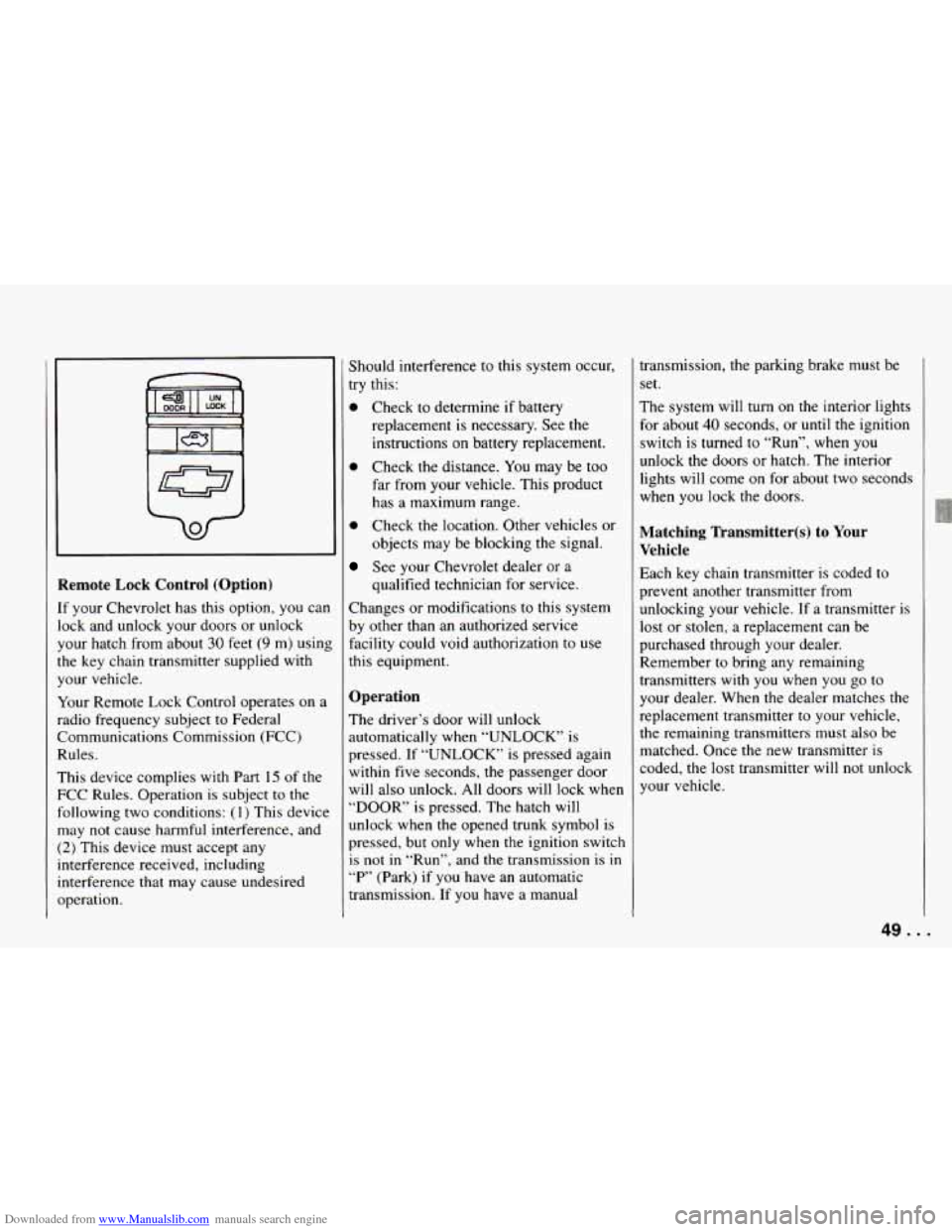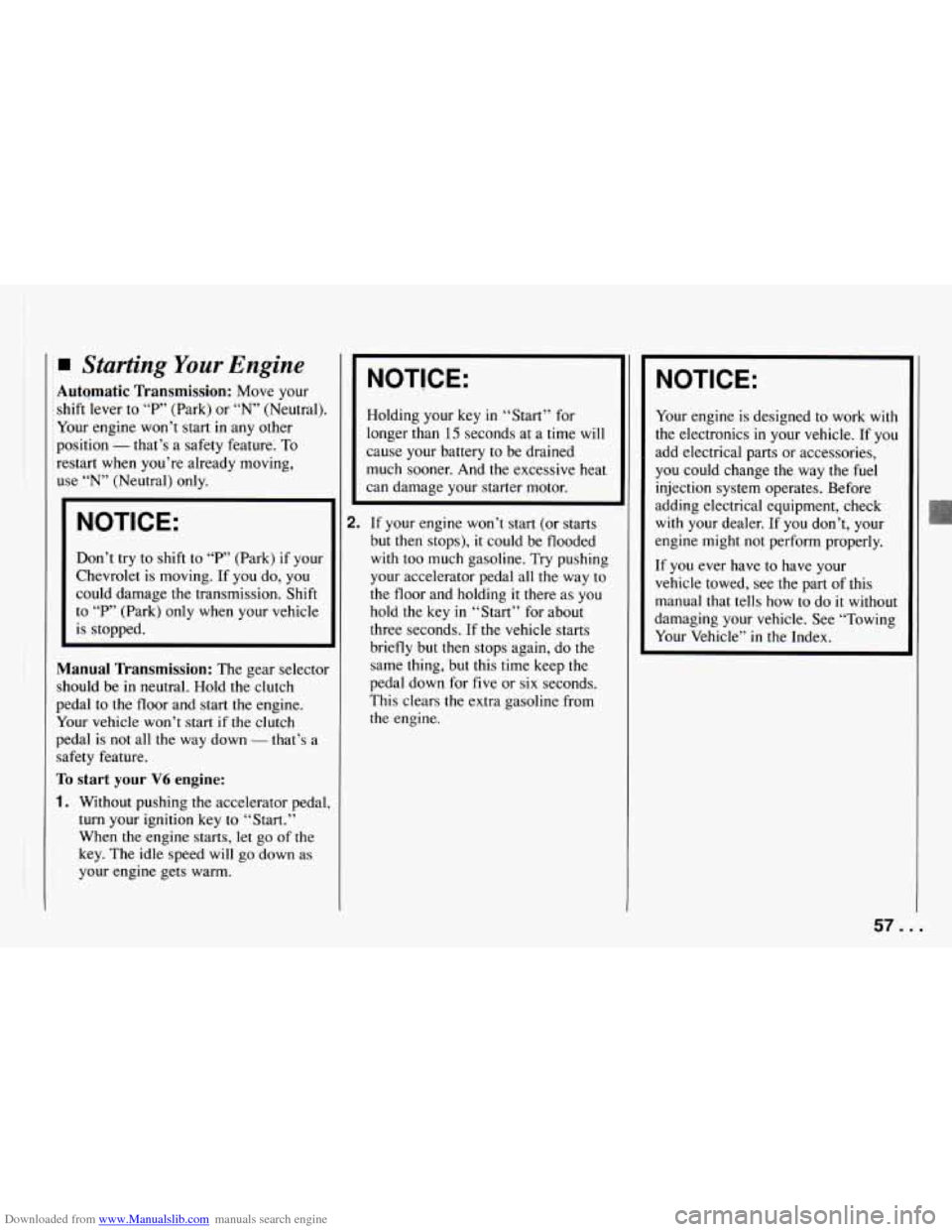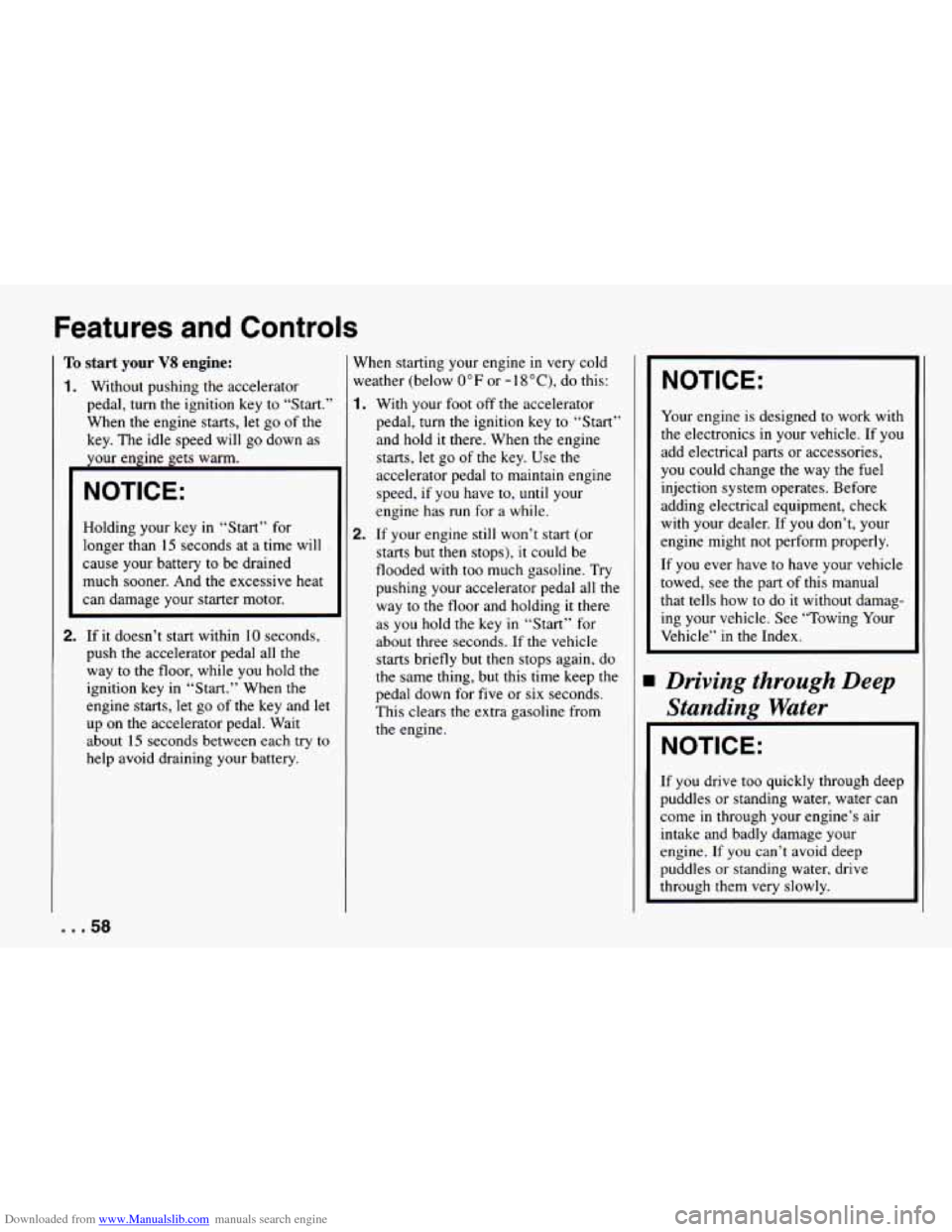change key battery CHEVROLET CAMARO 1994 4.G Owners Manual
[x] Cancel search | Manufacturer: CHEVROLET, Model Year: 1994, Model line: CAMARO, Model: CHEVROLET CAMARO 1994 4.GPages: 292, PDF Size: 15.35 MB
Page 51 of 292

Downloaded from www.Manualslib.com manuals search engine I9
Remote Lock Control (Option)
If your Chevrolet has this option, you can
lock and unlock your doors or unlock
your hatch from about
30 feet (9 m) using
the key chain transmitter supplied with
your vehicle.
Your Remote Lock Control operates on a
radio frequency subject to Federal
Communications Commission (FCC)
Rules.
This device complies with Part
15 of the
FCC Rules. Operation is subject to the
following two conditions:
(1) This device
may not cause harmful interference, and
(2) This device must accept any
interference received, including
interference that may cause undesired
operation. Should interference
to this system occur,
try this:
0 Check to determine if battery
replacement is necessary. See the
instructions on battery replacement.
0 Check the distance. You may be too
far from your vehicle. This product
has a maximum range.
0 Check the location. Other vehicles or
objects may be blocking the signal.
See your Chevrolet dealer or a
qualified technician for service.
Changes or modifications to this system
by other than an authorized service
facility could void authorization to use
this equipment.
Operation
The driver’s door will unlock
automatically when “UNLOCK’ is
pressed. If “UNLOCK” is pressed again
within five seconds, the passenger door
will also unlock. All doors will
lock when
“DOOR” is pressed. The hatch will
unlock when the opened trunk symbol is
pressed, but only when the ignition switch
is not
in “Run”, and the transmission is in
“P’ (Park) if you have an automatic
transmission. If you have a manual transmission, the
parking brake must be
set.
The system will
turn on the interior lights
for about
40 seconds, or until the ignition
switch is turned to “Run”, when you
unlock the doors or hatch. The interior
lights will come on for about two seconds
when you lock the doors.
Matching Transmitter(s) to Your
Vehicle
Each key chain transmitter is coded to
prevent another transmitter from
unlocking your vehicle. If a transmitter is
lost or stolen, a replacement can be
purchased through your dealer.
Remember to bring any remaining
transmitters with you when you
go to
your dealer. When the dealer matches the
replacement transmitter to your vehicle,
the remaining transmitters must also be
matched. Once the new transmitter is
coded, the lost transmitter will not unlock
your vehicle.
49. .
Page 59 of 292

Downloaded from www.Manualslib.com manuals search engine Starting Your Engine
Autamatic Transmission: Move your
shift lever to
“P” (Park) or “N’ (Neutral).
Your engine won’t start
in any other
position
- that’s a safety feature. To
restart when you’re already moving,
use
“N’ (Neutral) only.
NOTICE:
Don’t try to shift to “P’ (Park) if your
Chevrolet is moving. If you do, you
could damage
the transmission. Shift
to
“P” (Park) only when your vehicle
is stopped.
Manual Transmission: The gear selector
should be in neutral. Hold the clutch
pedal to the floor and start the engine.
Your vehicle won’t start if
the clutch
pedal is not all the way down
- that’s a
safety feature.
To start your V6 engine:
NOTICE:
Holding your key in “Start” for
longer than
15 seconds at a time will
cause your battery to be drained
much sooner. And the excessive heat
can damage your starter motor.
2. If your engine won’t start (or starts
but then stops),
it could be flooded
with too much gasoline. Try pushing
your accelerator pedal all the way to
the floor and holding
it there as you
hold the key in “Start” for about
three seconds. If the vehicle starts
briefly but then stops again, do the
same thing, but this time keep the
pedal down for five or
six seconds.
This clears the extra gasoline from
the engine.
NOTICE:
Your engine is designed to work with
the electronics
in your vehicle. If you
add electrical parts or accessories,
you could change the way the
fuel
injection system operates. Before
adding electrical equipment, check
with your dealer. If you don’t, your
engine might not perform properly.
If you ever have to have your
vehicle towed, see the part of this
manual that tells how to do
it without
damaging your vehicle. See “Towing
Your Vehicle”
in the Index.
1. Without pushing the accelerator pedal
turn your ignition
key to “Start.”
When
the engine starts, let go of the
key. The idle speed will
go down as
your engine gets warm.
57.
Page 60 of 292

Downloaded from www.Manualslib.com manuals search engine Features and Controls
To start your V8 engine:
1. Without pushing the accelerator
pedal,
turn the ignition key to “Start.”
When the engine starts, let go of the
key. The idle speed will go down as
your engine gets warm.
NOTICE:
Holding your key in “Start” for
longer than
15 seconds at a time will
cause your battery to be drained
much sooner. And
the excessive heat
can damage your starter motor.
2. If it doesn’t start within 10 seconds,
push the accelerator pedal all the
way to the floor, while you hold the
ignition key in “Start.” When the
engine starts,
let go of the key and let
up on the accelerator pedal. Wait
about
15 seconds between each try to
help avoid draining your battery. When starting
your engine
in very cold
weather (below
0°F or -18”C), do this:
1.
2.
With your foot off the accelerator
pedal,
turn the ignition key to “Start”
and hold it there. When the engine
starts, let go of the key. Use the
accelerator pedal to maintain engine
speed, if you have to,
until your
engine has
run for a while.
If your engine still won’t start (or
starts but then stops),
it could be
flooded
with too much gasoline. Try
pushing your accelerator pedal all the
way to the floor and holding
it there
as you hold the key
in “Start” for
about three seconds. If the vehicle
starts briefly but then stops again, do
the same thing, but this time keep the
pedal down for
five or six seconds.
This clears the extra gasoline from
the engine.
NOTICE:
Your engine is designed to work with
the electronics in your vehicle. If you
add electrical parts or accessories,
you could change the way
the fuel
injection system operates. Before
adding electrical equipment, check
with your dealer. If you don’t, your
engine might not perform properly.
If you ever have to have your vehicle
towed, see the
part of this manual
that tells how to do it without damag-
ing your vehicle. See “Towing Your
Vehicle” in the Index.
Driving through Deep
Standing Water
NOTICE:
If you drive too quickly through deep
puddles or standing water, water can
come in through your engine’s air
intake and badly damage your
engine. If
you can’t avoid deep
puddles or standing water, drive
through them very slowly.
... 58